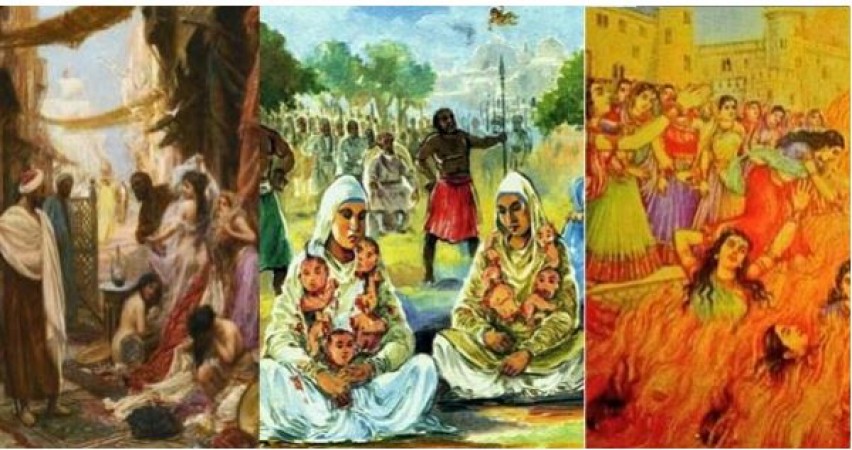
In the pages of history, certain tragedies remain overshadowed by others, their voices muffled by the passage of time. One such tragedy is the colossal holocaust that unfolded in India, spanning over 800 years. Often overlooked, the atrocities endured by Hindus, Sikhs, and Buddhists during the Arab, Afghan, Turkish, and Mughal invasions are a grim reminder of the depths of human suffering.
The Invasions Begin: Mahmud Ghazni and Beyond
Around 1000 AD, India was invaded by Mahmud Ghazni, heralding the start of a long series of invasions that continued for centuries. These incursions introduced a period of darkness, where the blood of innocents flowed and civilizations were razed to the ground. One account from the contemporary chronicler ‘Tarikh-i-Yamini’ recounts how the city of Thanesar witnessed the slaughter of so many Hindus that their blood turned the stream red, and tens of thousands were slain.
Towers of Skulls and Pillars of Horror
As history unfolded, the horrors multiplied. Nadir Shah, in Delhi, constructed a mountain of Hindu skulls as a gruesome testament to his power. Babur, the Mughal emperor, raised towers of Hindu heads to commemorate his victories. The pages of Babur's own memoirs resonate with his own words glorifying the killings, painting a chilling portrait of brutality. Akbar, a name often praised for governance, ordered the massacre of 30,000 Rajputs after capturing Chithorgarh in 1568. The Bahamani Sultans, in a horrific agenda, aimed to kill a minimum of 100,000 Hindus annually.
Voices of the Witnesses
Contemporary accounts of these heinous events remain as testament to the enormity of the tragedy. Chroniclers of invading armies and subsequent rulers left behind chilling records of the atrocities they committed. The documented genocide of millions of Hindus, Sikhs, Buddhists, and Jains, alongside mass rapes of women and the destruction of temples and libraries, is a haunting proof of the world's largest holocaust.
Quotes from Modern Historians
Renowned historians have cast light on this dark history. Dr. Koenraad Elst notes that Islamic warriors killed more Hindus over 13 centuries than the Holocaust victims. The historian Will Durant likened the Mohammedan conquest of India to "the bloodiest story in history." Alain Danielou, in 'Histoire de l’Inde,' paints a vivid picture of these conquests as unparalleled in history.
Legacy and Lessons
The impact of these invasions reverberates in the very fabric of India's being. The scars of the past, often unspoken, shape the country's identity and resilience. While the world acknowledges various genocides, the silence surrounding India's own tragedy is a poignant reminder that history's injustices are not always granted equal attention.
Facing a Similar Threat
Today, as terrorism and extremist ideologies threaten the world, the lessons of history stand as a stark warning. Organizations like ISIS, Taliban, and Al-Qaeda carry echoes of the ideologies that fueled the historic horrors in India. Understanding the past is essential in preventing its repetition. The brave resistance of figures like Guru Gobind Singh and Shivaji Maratha serve as inspirations, showing that even in the darkest times, heroes emerge to fight for justice.
Remembering the Forgotten
The world has an ethical responsibility to remember the forgotten holocaust of India. The millions of lives lost, the heritage destroyed, and the suffering endured should not be buried in the annals of history. As we grapple with the complexities of our past, let us learn from the mistakes and atrocities committed, and ensure that the lessons of history illuminate our path toward a more just and compassionate future.
The Role of Women in India's Struggle for Independence
Bhagat Singh: The Youth Icon of India's Struggle for Freedom
Partition of India: The Painful Journey to Nationhood